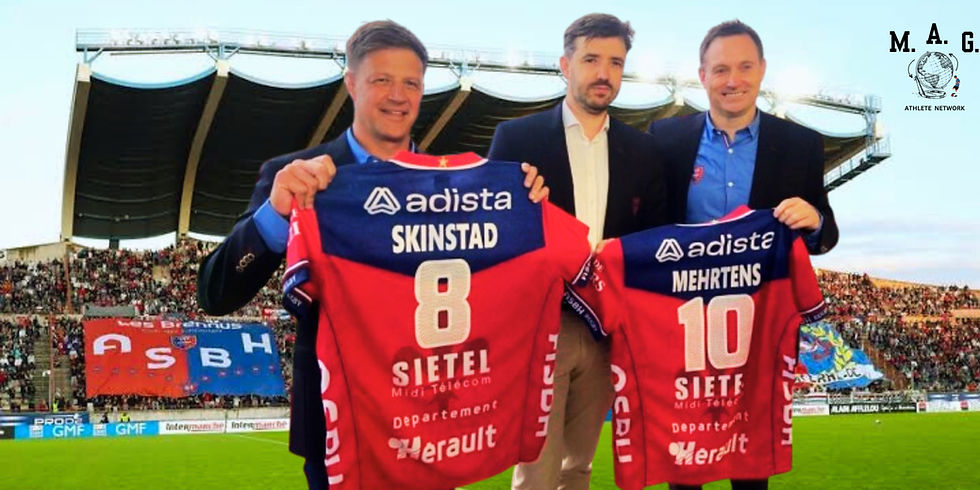Bob Skinstad and Andrew Mehrtens' Team Ownership Move: Next-Level Pioneering for Former Players
- Chester Khangelani Mbekela

- Feb 3
- 4 min read

Article by: Zila Mbekela

The world of professional rugby has long been dominated by club owners with business or corporate backgrounds, but former Springbok captain Bob Skinstad and legendary All Black fly-half Andrew Mehrtens are breaking new ground. The duo has recently become part-owners of French Pro D2 club AS Béziers Hérault, marking a significant shift in how former players reinvest in the game.
This move is not only a testament to their commitment to rugby but also a potential blueprint for future generations of ex-players who wish to stay actively involved in the sport beyond coaching and commentary.
A Game-Changing Move
For years, retired rugby players have found themselves at a crossroads—either staying in the game through coaching, media work, or stepping away completely. The decision by Skinstad and Mehrtens to take a direct stake in a professional club signals a bold new approach. Team ownership has traditionally been reserved for wealthy entrepreneurs, but with the growth of rugby as a global sport, financially savvy former players are now seeing an opportunity to shape the game at an administrative level.
Their involvement in AS Béziers Hérault represents more than just an investment; it is a commitment to the long-term development of the sport. By stepping into ownership roles, Skinstad and Mehrtens bring invaluable on-field experience and a deep understanding of what it takes to succeed at the highest level. Their presence could significantly influence the club’s structure, recruitment strategies, and overall direction.
Legends of the Game
Both Skinstad and Mehrtens enjoyed illustrious playing careers that saw them become icons in their respective nations. Skinstad, renowned for his dynamic playing style, captained the Springboks and played a pivotal role in South African rugby during the late 1990s and early 2000s. His ability to adapt and play multiple positions in the back row made him a unique asset to any team he represented, including the Stormers and Sharks in Super Rugby.
Mehrtens, on the other hand, was a maestro at fly-half for the All Blacks. With an exceptional kicking game, vision, and tactical awareness, he guided New Zealand through some of their most dominant years in the 1990s and early 2000s. His ability to control a game from the number 10 jersey made him one of the most respected playmakers in rugby history. Mehrtens' club career saw him play in various leagues, including the English Premiership and French rugby, giving him valuable insight into the European game.
A New Trend for Retired Players?
The move by Skinstad and Mehrtens raises an intriguing question: Could team ownership become the next chapter for former rugby stars? Traditionally, professional athletes have ventured into broadcasting, coaching, or commercial endorsements post-retirement. However, as rugby grows in financial stature, more players may begin exploring ownership as a viable career path.
Football has already seen this trend, with former players like David Beckham taking ownership stakes in clubs. Rugby, though a sport with fewer financial windfalls, could see a similar shift as athletes better manage their earnings and look for long-term investment opportunities. Players who have built strong personal brands and maximized their earnings during their playing days may now see club ownership as a way to maintain influence and contribute to the sport’s evolution.
Maximizing Earnings and Investing in the Future
The key to team ownership for former athletes is financial security. Rugby, unlike some of the more commercialized sports such as football or basketball, has historically seen lower salaries and endorsement deals. However, with the game expanding into new markets and sponsorship revenue increasing, elite players are now earning significantly more than their predecessors. Those who manage their finances wisely can explore long-term business ventures such as team ownership.
Skinstad and Mehrtens’ decision to become part-owners of AS Béziers Hérault underscores the importance of financial planning for athletes. By leveraging their rugby knowledge and networks, they are positioning themselves as key figures in the game’s administrative future. Their involvement could pave the way for other former players to follow suit, ensuring that rugby teams are led by individuals with a deep understanding of the sport’s demands and culture.
What It Means for AS Béziers Hérault
AS Béziers Hérault is a club with a rich history in French rugby, but it has struggled in recent years to return to its former glory. The arrival of Skinstad and Mehrtens as part-owners could provide the club with fresh energy, strategic leadership, and increased visibility. Their presence may also attract high-profile players and sponsors, further boosting the team’s chances of success.
Their influence will likely extend beyond the playing field. With their extensive experience in rugby media, business ventures, and player development, they could implement new strategies to enhance the club’s commercial appeal and community engagement. This approach aligns with the modern era of sports ownership, where former athletes use their brand power to grow the clubs they invest in.
A Legacy Beyond Playing
For Skinstad and Mehrtens, team ownership is more than just an investment—it is a legacy move. By stepping into these roles, they are ensuring that their contributions to rugby extend well beyond their playing days. This new venture allows them to shape the future of a club, mentor young players, and contribute to the professionalization of rugby as a business.
If this trend continues, we could see more former players stepping into ownership roles, thereby shifting the landscape of rugby governance. Clubs owned by former players may prioritize athlete well-being, long-term development, and a deep-rooted understanding of what it takes to win at the highest level.
Conclusion
The decision by Bob Skinstad and Andrew Mehrtens to become part-owners of AS Béziers Hérault is a groundbreaking move in the world of rugby. It signals a shift where former players, equipped with financial security and business acumen, are taking direct control of clubs rather than merely influencing the game from the sidelines. Their investment not only benefits their club but also sets a precedent for future generations of rugby professionals.
As the game continues to evolve financially, could this be the dawn of a new era where former players take ownership of the very clubs they once played for? Time will tell, but one thing is certain—Skinstad and Mehrtens are pioneers in a movement that could redefine post-playing careers in rugby.
*If you want to support the blog, you can do so by getting yourself some new merch:
*If you want to learn how to become a sports agent, check out our online course:











Comments